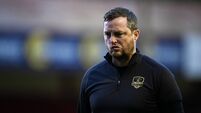DR ED COUGHLAN: Coaches can reap the benefits of putting themselves in the picture

Salvador Dali once said, have no fear of perfection, you’ll never reach it.
Coaches are rarely naïve enough to ever think of perfection, but they’ll often think of better.
The challenge to find better, as a coach, can be a difficult task.
Time is often the greatest barrier to coach self-improvement. There is always something to be done, a session to be prepared for, a player to follow up with, or a colleague to meet. Then finally, when the coaching boxes are ticked and there is a moment to breathe, there is often a gentle reminder of the rest of your life that needs attending to, such as family and friends.
Yet, the concept of being busy can often mask opportunities for learning and improvement. It is not new thinking to consider that a little self-investment may end up saving time and energy in the long run. However, the decision on what to do and more importantly how to do it can be as challenging as getting started in the first place.
One obvious place to kick-start the process is to engage in some peer evaluation. To ask a colleague to observe you as you coach. It is worth stating from the outset that this is the proverbial deep end of self-improvement as a coach. To invite opinion on your work is one thing, but to engage in the feedback is quite another, especially when there is a great likelihood that some of the interaction will sting you to the core of your being.
The knee-jerk reaction in this situation is often to parry away any observations by providing a context and a rationale, assuming that the observer misinterpreted what they saw. When they persist with their points for consideration, the next stage is to question their credentials to be able to make such judgements on your coaching. Coaching that has served you very well, up until this point (thank you very much). Finally, when relations begin to completely break down, the observer kindly reminds you that they were originally asked to do this as a favour, to which they are generally met with some comment suggesting that the feedback was not expected to be so brutal. Any previous agreement to observe each other, in turns, is quickly forgotten about and a cooling off period is engaged in without anyone needing to suggest it.
In lieu of peer evaluation, and possibly a gentler step into the sometimes (often) harsh world of feedback, there is one well-known and very powerful tool that coaches can engage in, in the privacy of their own space, known as time motion analysis. In its simplest form, it requires a video camera and some time afterward to review the footage.
A time-motion analysis is as it sounds; an analysis of the activities that make up a training session. It provides the coach with an opportunity to observe themselves in action. Possibly, also hear their interaction with the players and then watch the player’s behaviours in response to their coaching. It can prove useful for all types of coaches, from the proactive, hyper-organised coach, who has every detail of the session planned in advance to the more laidback, reactive coach, who coaches a session based on what unfolds in front of them and every type in between.
For the obsessive planner, the process of a time-motion analysis is quite straightforward. The same planning and organisation goes into the session as usual, as this paperwork will prove useful in the post-session analysis. For starters, make sure the camera is set up in a good vantage point to capture the action. Ideally, if there was a trusted person to operate the video, they would follow the action and zoom in and out as required, but this is not essential. Either way, the camera should be in position ready to record before anyone, coach or player, takes to the field.
Assuming the batteries are well charged and the memory card is cleared beforehand, there is nothing left to do but run your session as you normally would. It is not uncommon to be a little self-conscious in those early few minutes knowing that everything is being captured.
But this soon passes as the presence of mind required to engage with the players soon replaces any distraction from the sidelines.
Only stop recording when the session is well and truly done, to capture any additional activity that may unfold that may otherwise have been overlooked. For example, players often see this time as opportunity to get some extra work done, something small to fine-tune a specific skill.
However, these seemingly harmless add-ons can often result in an additional 15-20 minutes of kicking or striking. The kind of work that is often associated with dead ball specialists such as Jonny Sexton, Patrick Horgan, and Dean Rock.
This is by no means to suggest that they should not do this work, but more to be reminded to consider it when calculating their workload for the session and cumulatively, for the week, every week throughout the season.
The next most difficult step in the process is to commit time to reviewing the footage. Ego has a big part to play in this ever being done. But the learnings, though hard to take, will be worth it.
Before pressing play on the video, review the plan for the session. Go through the rationale for why each segment was included in the session.
This can often be related to the most recent performance. A team that leaked too many goals will endeavour to work on the defence of the goalmouth in the next session. Handling errors that were deemed costly the last day out would be made a priority at training.
This is where the time motion analysis becomes so worthwhile. Coaches will often realise that they speak a lot more than they thought, choosing to over-explain something before letting the players at it themselves. They’ll often reflect on how long ‘a quick water break’ actually takes and how setting up certain scenarios on the field appear to take forever to get ready.
The more regimented coaches will go from patting themselves on the back because everything went exactly to time to realising it may be more important to stick with something until a meaningful change has been experienced rather than stopping because the plan said it was time to move on.
Oftentimes, the spread of a session is where most gains are made. Puzzlingly, the priority of the session, as agreed beforehand, receives the same or only marginally more time than other less important aspects.
The staple diet that makes up most training sessions is revealed as exactly that, a box-ticking exercise in getting through the session. The belief that every aspect of the game needs to be touched on in every session is the epitome of spreading your efforts too thin.
However, such clarity is often hard to see when you are so immersed in the work. An outside perspective can enable you to see the wood for the trees and begin to sharpen the focus of your next training session, even how the next performance will be viewed.
So before you think that you can do better than someone else does, take some time to examine how you can better yourself. Your players will thank you for it.















